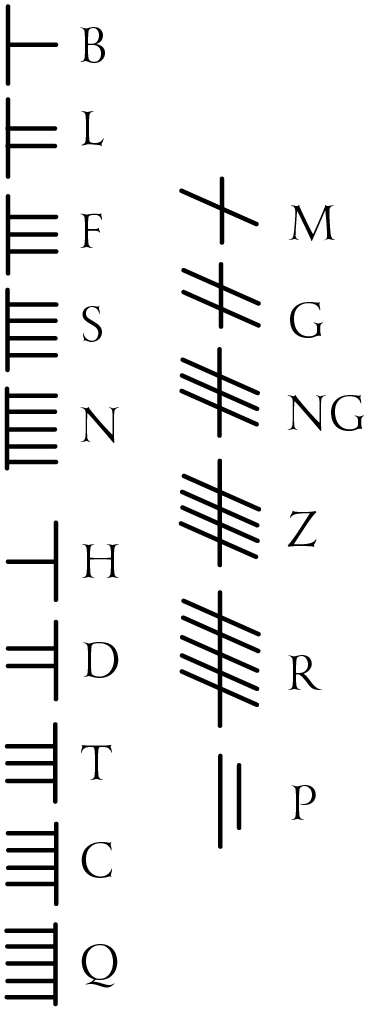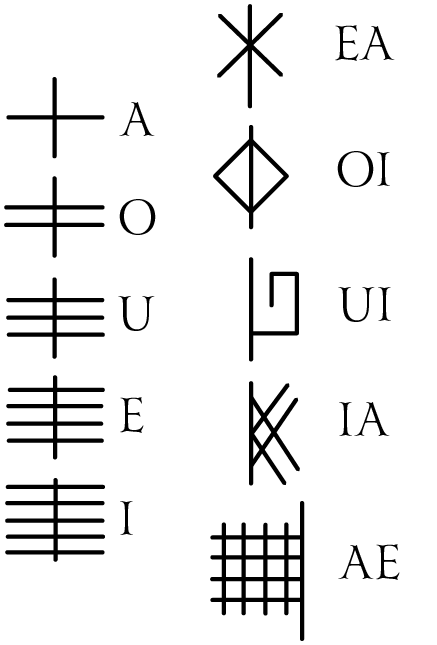
Ogham is often characterised and described as a mnemonic “tree alphabet” and is used by many in the Druid tradition. As a Hedge Druid, it is entirely your choice as to whether or not you incorporate it into your path. The pronunciation of the word depends on which part of Ireland you are coming from and to which period in time you are referring (medieval Irish vs. modern Irish, for example). Sometimes it is pronounced “oham” or “oh-am,” other times “ogam,” and more.
The ogham alphabet consists of twenty letters, with an additional five that were added at a different date to enable people to write in words of Greek origin. There are sounds in the Greek language that are not found in Irish and vice versa. The Druids spoke many languages, Greek being one of them. And as we all know, some words just aren’t translatable! Some Druids use the extra five letters, some do not.
There is large debate over the origins of the ogham alphabet. The earliest recorded ogham that we can find goes back to the third and fourth centuries and was carved on stone. So the ogham is slightly less than two thousand years old; however, the linguistics suggest that it is far older than the carved stones themselves, and by the time of its recording in stone it had already been in existence for perhaps a few hundred years, if not more. Some myths describe the ogham as being written on wood. Heroes might carve letters onto a branch during their quest to let others know of their deeds and whereabouts. If ogham was indeed carved on wood as portrayed in myth, actual carvings on wood have not survived in the damp and rainy climate of Ireland, where it would have rotted quickly. Archaeologists have yet to discover preserved wood with ogham written on it. Ogham is also found in manuscripts from the Christian period.
The tree alphabet was described and popularised by Robert Graves in his work The White Goddess. However, this is just one of one versions of the 150 different types of ogham, described in the work The Scholar’s Primer, a seventh-century work of Irish grammarians, written by a scholar named Longarad. The tree ogham specifically has taken root (if you’ll pardon the pun) in Modern Druidry and Paganism, due to the proliferation of Graves’s work and our love of trees. However, there is also pool ogham, which is derived from harbours, lakes, rivers, and other bodies of water. There is king ogham, named after kings as its name suggests. We also find trade ogham, where each letter is named after a specific trade. We’ve seen that it can be used in hand ogham, for signing without speech, alongside shin ogham and nose ogham. There is a colour ogham and even a bird ogham for all you bird lovers out there.
The Scholar’s Primer (the texts of the ogham tract from the Book of Ballymote and the Yellow Book of Lecan as well as the text of the Trefhocul from the Book of Leinster) suggests that the ogham came from the god Ogma, Oghma, or Ogham, however you wish to spell or pronounce it. It states that Ogma is the father of the alphabet and Ogma’s wife is the mother (her name uncertain). We can find alphabets, runes, and writings derived from deities the world over, such as in the Norse or Egyptian traditions. A mythical account is but one of many.
The shape of ogham helps to make it easy to carve into stone or wood. It also makes it easy to sign with using your hands. It might have been developed in order to preserve a formally oral religious tradition, as the Roman Empire continued to expand and the fate of the Celts became less and less certain. Certainly travellers to the continent would have seen Latin inscriptions all over the place and may have been inspired to do something similar to save some vestiges of their own culture. In effect, this would indicate that it was of Pagan origin, rather than Christian.
You can find standing stones with ogham travelling up one side of the stone and over and down the other side, depicting lineages of kings. Sometimes they indicate which tribal territory they are from. Ogham has been used for many ancient secular signposts, if you will. Ogham was formerly used in a very mundane way, but today’s Druids and Pagans apply a more mystical approach to it. Whether it was originally a mystical alphabet or not, we may never be sure. We can agree that ogham is magical in that as a written alphabet, it can connect us with the past, speaking to us from millennia past and allowing us to communicate with the ancestors. It frees us from space and time, as all written words do. They will live on.
Translating the ogham is another tricky matter. Linguists differ in their interpretations of each letter, and so if you want to use the ogham in your practice, you will have to find a translation that makes sense and works for you.
Many Modern Pagans and Druids use the ogham in a divinatory manner. In some myths we see the use of ogham in order to determine past events, what happened then, and so on. But today the preference is to look ahead into the future, much like any other popular divinatory system such as the runes or tarot. Fidlann is a term for “casting lots” and, as fid translates to “wood,” this could be ogham divination. You can make your own set of ogham staves for divination purposes by carving the ogham onto a piece of wood. If you want to be very specific, you can carve the relevant ogham onto the relevant wood then cast the staves onto the ground or flat surface. From where they land and which ones are readable, you can divine what it is that you need to know. Below I’ve included the ogham alphabet:
Ogham Alphabet—twenty letters:

Ogham Alphabet—additional five letters (left) and typographic ligatures (right)

Here are the main twenty trees of the popular tree ogham in greater detail and some of their divinatory meanings. Some of these trees were known as chieftain trees and were protected under Ireland’s indigenous Brehon law, which was in existence prior to the establishment of English common law. Brehon law/lore was a civil law officially formed in early medieval Ireland, stemming from an even earlier oral form. Brehons were similar to judges and memorised laws to settle disputes.
|
Name |
Letter |
Meaning |
|
Beith (Birch) |
|
Sacred tree of Brehon lore; new beginnings, fast growth; associated with courage and the pioneering spirit; cleansing and purifying; a new phase in life; feminine energy and focus |
|
Luis (Rowan) |
|
Sacred tree of Brehon lore, sacred to goddess Brighid; protection, perspective, and wit; Faery and Otherworld influence |
|
Fearn (Alder) |
|
Sacred tree in Brehon lore; prophecy and sacrifice; associated with the god Bran; confidence; power and warrior spirit; balancing emotions; masculine |
|
Saille (Willow) |
|
Sacred tree of Brehon lore; balance, harmony; emotions and healing; divinity and spirit; beauty |
|
Nuin (Ash) |
|
Sacred tree of Brehon lore; strength and courage; righteousness; warrior and wisdom; inspiration; death; sovereignty |
|
Huath |
|
Sacred tree in Brehon lore; Otherworld influence; challenge and transformation; honour; declaring boundaries; Faery tree |
|
Dair (Oak) |
|
Chieftan tree in Brehon lore, above all others; strength; commitment; doorway; growth; divinity and sovereignty; truth; knowledge and wisdom; balance; associated with Brighid |
|
Tinne (Holly) |
|
Sacred tree in Brehon lore; associated with the god Taranis; persistence, strength, and endurance in hardship; protection; warrior spirit; masculine energy |
|
Name |
Letter |
Meaning |
|
Coll (Hazel) |
|
Sacred tree in Brehon lore; divinity and divine guidance; inspiration and awen; balance and alignment; potential; integration and relationship; wisdom; protection; divination |
|
Quert (Apple) |
|
Sacred tree of Brehon lore; Otherworld gifts and blessings; holistic well-being; healing; magic |
|
Muin (Vine or blackberry) |
|
Bounty and harvest; fruits of labour; cycles of growth, death, and decay; gifts and blessings; sacrifice |
|
Gort (Ivy) |
|
Tenacity and perseverance; endurance; connection and relationship with others; feminine energy |
|
Ngetal (Reed, Broom, or Fern) |
|
Skill of mind and body; independence; discretion; conscious choices; associated with Brighid |
|
Straif (Blackthorn) |
|
Magical aptitude and skill; Otherworld influence; protection; boundaries |
|
Ruis (Elder) |
|
Faery tree; Otherworld connection; sacrifice and atonement; equilibrium; transition; death; magic; protection |
|
Ailm (Scots Pine or |
|
Sacred tree in Brehon lore; quiet wisdom and contemplation; calm and peace; new perspectives; inspiration; immortality |
|
Furze or Onn (Gorse) |
|
Fire in the head; fire in the belly; fertility; new ideas and plans; renewal; power; purification |
|
Ur (Heather) |
|
Cycles and regeneration; opportunity; connection; community; tribe; good fortune |
|
Eadha (Aspen or Poplar) |
|
Communication; movement; signal that a change may be required; sacrifice; death |
|
Idho (Yew) |
|
One of longest-living trees on earth; perseverance; quiet and calm; patience; endurance; regeneration; cycles of life and death; blessings; silence and quietude; immortality; the Otherworld |
This is a brief glance into the ogham. A full account of the ogham is beyond the scope of this work and indeed there are many books solely dedicated to the ogham and Celtic tree lore and magic. I encourage you to seek these out, do your own research, and if this interests you, to dive deeper into the world of Celtic trees and their wonderful mysteries.

She throws the ogham staves upon the shingle beach before her. They rattle among the stones, and she uses those closest to her and whose symbols are the most visible for divination. She allows the sound of the waves pushing and pulling the rounded stones along the shoreline to lull her into a trance, and slowly the ogham begin to form a pattern in her mind, showing her what it is that she needs to do, what it is that she needs to know.



















